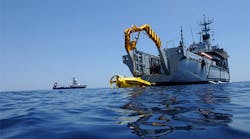A client recently asked me to investigate and solve a recurring problem on a diving bell launch and recovery system. The system comprised of a hydraulic power unit, a bell winch, an umbilical winch and a guide-wire winch.
To launch the bell, the guide-wire winch is used to lower a clump weight to the seabed (the guide wires prevent the bell from spinning during launch and recovery) and then the bell and its umbilical are launched using their respective winches.
After the divers have finished their shift on the seabed (usually 6-8 hours) the bell and its umbilical are recovered, followed by the clump weight.
The problem was occurring during recovery of the clump weight with the guide-wire winch. The hydraulic motor on this winch was of radial piston design. When the winch was summoned to haul up the clump weight, the distributor shear pin (designed to prevent torque from being applied to the distributor valve), was frequently shearing, rendering the winch unserviceable. Once this pin has sheared, the distributor must be removed from the motor and the pin replaced. Apart from the obvious inconvenience, this was resulting in costly downtime. And the cause of this problem was temperature shock.
When there is a significant difference between the temperature of a hydraulic pump or motor and the oil being supplied to it, rapid, localized heating of the internal parts of the component can occur. This causes individual parts of the component to expand at different rates, resulting in interference between parts that normally have fine clearances.
Temperature shock occurs when part of a hydraulic circuit is operated for long enough for the hydraulic fluid in the system to reach operating temperature, and then a previously idle part of the circuit is functioned. This results in hot oil being delivered to cold components.
In the example described above, due to the length of time between the launch of the bell and its recovery, the entire hydraulic system was at ambient temperature at the start of the recovery operation.
By the time the bell and its umbilical had been hauled up 450 feet and were safely on deck, the hydraulic oil was at operating temperature (hot). But the guide-wire winch, which had been idle during this time, was still at ambient temperature (cold).
When the guide-wire winch was operated to recover the clump weight, the hot oil entering the cold motor was causing the distributor valve to expand and bind in its housing, resulting in failure of the shear pin and rendering the motor unserviceable.
The solution to this problem and the fix in the above example is quite simple. To prevent temperature shock of hydraulic motors, the motor's case must be continuously 'flushed' (positive circulation of a relatively small volume of oil through the case). This ensures that the motor is always at the same temperature as the oil in the system.
As you can see, delivering hot oil to cold hydraulic components can cause real problems. And to discover six other costly mistakes you want to be sure to avoid with your hydraulic equipment, get "Six Costly Mistakes Most Hydraulics Users Make... And How You Can Avoid Them!" available for FREE download here.

Continue Reading
Continue Reading
BOOK 2, CHAPTER 12: Fluid Motor Circuits
March 18, 2009
Motor leakage variations
Oct. 18, 2006
Sponsored Recommendations
Sponsored Recommendations
How Variable Volume Pumps Work
Feb. 6, 2024
What is a Check Valve and How Does it Work?
Feb. 6, 2024
